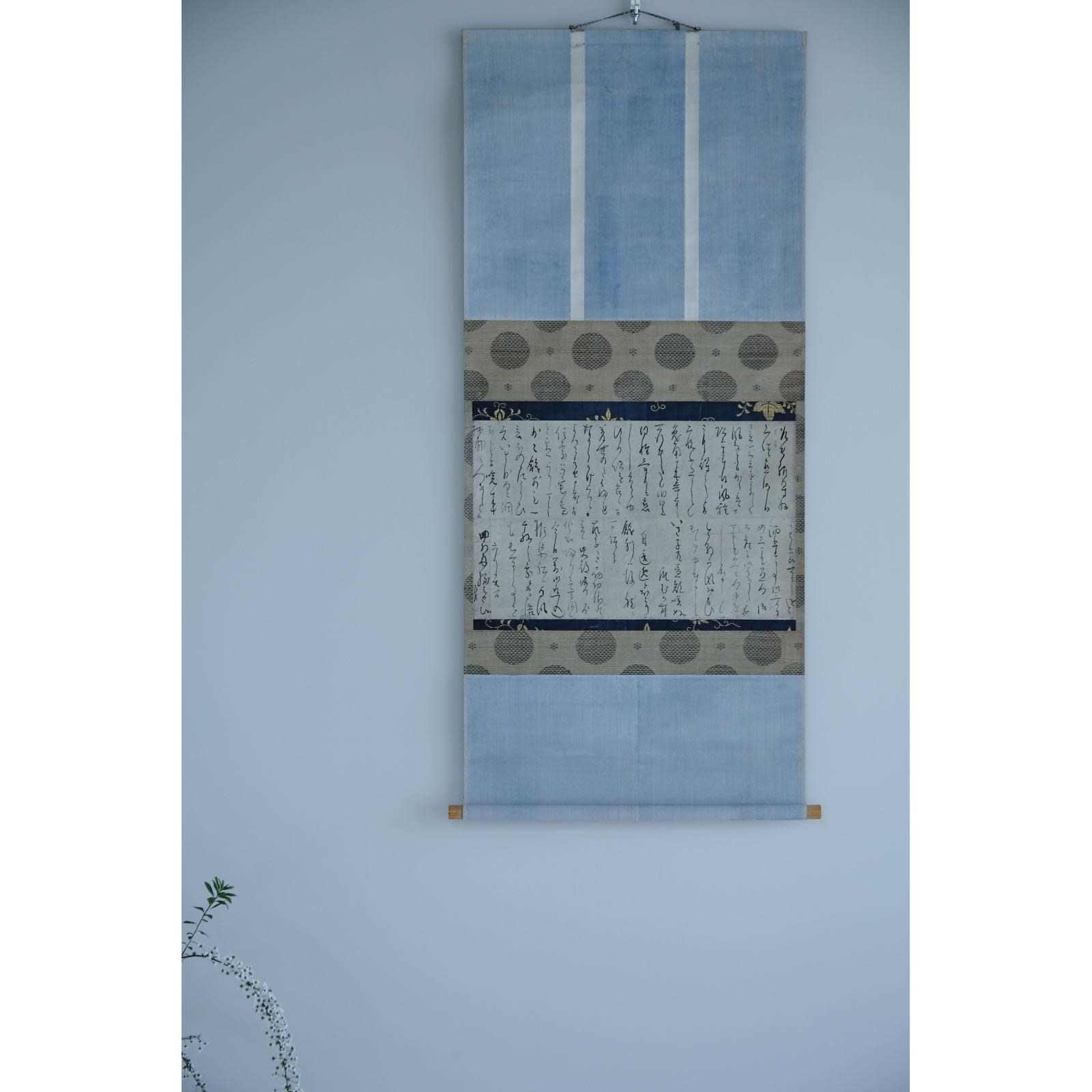Matsuo Bashō (1644–1694)
Letter to Suganuma Kyokusui
Ink on paper, hanging scroll
Dated the 21st day of the 6th month
28.8 x 46.8 cm
115 x 50 cm (overall)
Dated the 21st day of the 6th month
28.8 x 46.8 cm
115 x 50 cm (overall)
Further images
Exhibitions
Basho: shinshutsu sakuhin o chushin ni II. Itami: Kakimori Bunko, 2016. cat. no. 16.
This hanging scroll consists of a letter from Basho to his pupil, the samurai and poet Suganuma Kyokusui (1659–1717). Its contents pertain to a farewell for Kyokusui, who was returning to his home in Zeze Domain after having served his duty in Edo from the eighth month of 1692. The letter, dated the twenty-first day of the sixth month without the year written, appears to have been written in Genroku 6 (1693).
Basho begins by touching upon Kyokusui’s departure and expressing his delight in his disciple’s understanding of and achievement in haikai, or comic verse. He jokes that since Kyokusui’s younger brother Dosui, who returned first to Zeze, had dearly missed Basho, so Basho wanted to surprise Dosui with a visit. He also mentions that he had not yet finished his parting gift of words for Kyokusui, so he would dispatch someone to Rinpo in the evening and send his letter at that time. Basho expresses his hope that Kyokusui and [Hamada] Shado would discuss his “foolish” poem since Shado had been reprimanded.
Rinpo and Shado here refer to Basho’s disciples who also came from Zeze. In 1694, Shado and a fellow pupil Emoto Shido participated in a heated poetry con- test, which Basho arbitrated, in Osaka. A missive by Basho to Shado , predating the letter here, reveals that the teacher had rebuked his pupil for trying to make a name for himself in Osaka. Noteworthy is the mention of Shado in the present letter. In the morning, Basho thought up of a poem and included it in his parting letter to Kyokusui: “Children, the bindweed flowers blossom as I peel a melon.” Basho appeared to have been fond of this poem as he also inscribed it in a letter to another pupil Hakusetsu, dated the twentieth day of the eighth month of 1695, and boasted in the present letter, “If I do say so myself, I feel proud that [this poem is] excellent.” Basho must have read this superb verse inviting children to come and eat a chilled melon on a hot summer day. The master concludes with mention of the current status of Matsukura Ranran, Nakamura Fumikuni, and a few other disciples.
This letter is valuable as it offers glimpses of the relationships between Basho and his students. In addition to the first draft of Basho’s poem, the letter touches upon the closeness of the brothers Kyokusui and Dosui as well as signs of the impending problems with Shado.
Matsuo Basho (haiku poet; 1644−1694)
Also known as Munefusa; Tosei; Hakusendo; Bashoan; etc.
Iga-born mid Edo period haiku poet. First learned the Teimon-ha style of haiku poetry composition after Kitamura Kigin, and later gained inspiration from the Danrin-ha style after moving to Edo. Through numerous travels, Basho set up the Shofu style that had elevated haiku to a form of high art.
Basho begins by touching upon Kyokusui’s departure and expressing his delight in his disciple’s understanding of and achievement in haikai, or comic verse. He jokes that since Kyokusui’s younger brother Dosui, who returned first to Zeze, had dearly missed Basho, so Basho wanted to surprise Dosui with a visit. He also mentions that he had not yet finished his parting gift of words for Kyokusui, so he would dispatch someone to Rinpo in the evening and send his letter at that time. Basho expresses his hope that Kyokusui and [Hamada] Shado would discuss his “foolish” poem since Shado had been reprimanded.
Rinpo and Shado here refer to Basho’s disciples who also came from Zeze. In 1694, Shado and a fellow pupil Emoto Shido participated in a heated poetry con- test, which Basho arbitrated, in Osaka. A missive by Basho to Shado , predating the letter here, reveals that the teacher had rebuked his pupil for trying to make a name for himself in Osaka. Noteworthy is the mention of Shado in the present letter. In the morning, Basho thought up of a poem and included it in his parting letter to Kyokusui: “Children, the bindweed flowers blossom as I peel a melon.” Basho appeared to have been fond of this poem as he also inscribed it in a letter to another pupil Hakusetsu, dated the twentieth day of the eighth month of 1695, and boasted in the present letter, “If I do say so myself, I feel proud that [this poem is] excellent.” Basho must have read this superb verse inviting children to come and eat a chilled melon on a hot summer day. The master concludes with mention of the current status of Matsukura Ranran, Nakamura Fumikuni, and a few other disciples.
This letter is valuable as it offers glimpses of the relationships between Basho and his students. In addition to the first draft of Basho’s poem, the letter touches upon the closeness of the brothers Kyokusui and Dosui as well as signs of the impending problems with Shado.
Matsuo Basho (haiku poet; 1644−1694)
Also known as Munefusa; Tosei; Hakusendo; Bashoan; etc.
Iga-born mid Edo period haiku poet. First learned the Teimon-ha style of haiku poetry composition after Kitamura Kigin, and later gained inspiration from the Danrin-ha style after moving to Edo. Through numerous travels, Basho set up the Shofu style that had elevated haiku to a form of high art.





